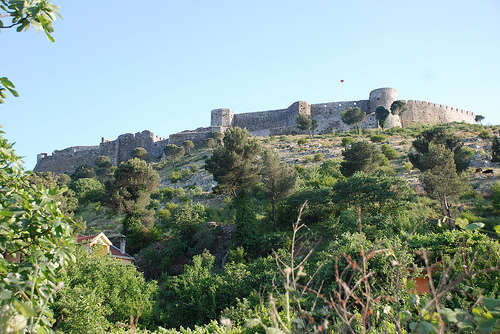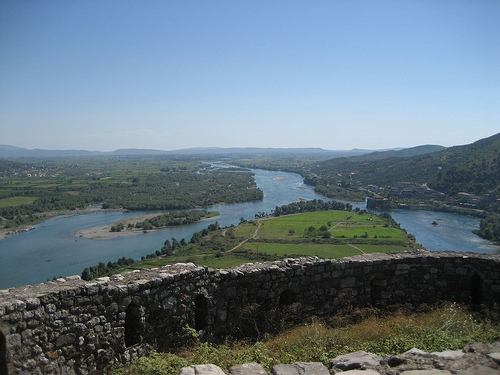


RozafaCastle Museum
Open: 8:00 to 19:00
Entry fee: 150 LEK
Rozafa Castle (Kalaja e Rozafës or Kalaja
e Rozafatit) is a medieval castle near the town of Shkoder in
Albania. The name of Rozafa Castle was based on an ancient legend
about its construction. According to her, the three brothers began
to build this stronghold. They worked all day, and at night their
walls fell apart. The local elder explained to them that the only
way to save their creation would be human sacrifice. One of the
brothers' wives had to be sacrificed before the castle was over. The
brothers decided that the first wife who would come to visit them
and become their victim is the key to their well-being. However, the
elder brothers did not keep their promise and warned their wives not
to come in the afternoon.
A wife of the youngest brother named Rozafa came the next day to visit her husband and bring him food and water. The victim was chosen and the brothers walled her within new citadel. The poor woman accepted her fate without regret and only asked her executioners to leave part of her outside the wall. The right eye, right chest, right arm and right leg were free. The rest of the woman was covered with stones. However, she could look at her baby, breastfeed him, hug him with his free hand and swing his cradle with her right foot until she died of hunger and grief. According to legend, if milk flows from her breast whenever enemies approach the city.
While the legend might be false it was fairly common to sacrifice and bury animals and even humans before the walls were erected. Bones that were discovered later during reconstruction projects might have given us the beginning of this legend.
The original citadel was built on this 113 meter hill in 350 BC
by the Illyrians, the ancient inhabitants of the North-Western
Balkans. This strategic hill stands at the confluence of the rivers
Buna and Drini. At one time there was a crossroads of river and land
roads. The Romans were able to take the stronghold of the local
lands in 167 BC and completely destroyed it. Most of Rozafa Castle
was built in the Middle Ages by the Venetians and Ottoman Turks who
built their castle here.
The confluence of the rivers Buna
and Drini

German author and explorer of the 19th century, Johann Georg von Han, suggested that the ancient medieval city of Shkodra was located directly south of Rozafa Hill, between the hill and the confluence of Buna and Drina. The fortifications have survived to the present, mainly of Venetian origin. Rozaf’s castle was the site of several famous sieges, including the siege of Shkodra by the Ottomans in 1478 and the siege of Shkodra by the troops of the Montenegrins in 1912. Rozafa castle and its surroundings form the archaeological park of Albania.

The fortress Rozafa was built on a hill with a maximum height of 130 meters, which controls the outflow of Lake Skadar over the Buna in a strategically favorable position. The Drin and Kir rivers pass the hill to the south. The slopes of the hill are very steep and rocky up to the walls. The extensive area of the castle in the shape of an irregular triangle includes the rather flat hilltop. Access is from the east, where the hill continues at a lower elevation.
Already in the 4th
century BC Illyrians founded a city on the hill called Scodra, which
is the predecessor of today's Shkodra. During Roman times it
extended to the plain at the foot of the hill.
Later,
Byzantines, local princes and Venetians used the facility. The
latter greatly expanded the fortifications.
In 1479 the Turks
were able to take the castle after ten months of siege. The castle
was inhabited until the second half of the 17th century. It was not
until 1863 that the administration of Vilayets Shkodra was moved
from the castle to the city center. The castle was used for military
purposes by the Ottoman army until 1913, when the Montenegrins
conquered the city.
The Rozafa fortress is one of
the most important sights in Shkodra and can be visited for a fee.
There is a small museum and folklore restaurant within the premises.
With the exception of the still solid fortification wall, which
mainly dates from the Venetian period, most of the castle's
buildings, including the rededicated St. Stephen's Church mosque,
have been destroyed. Access to the castle leads through several
gates and the massive outer wall. The area enclosed by this
comprises three courtyards that were separated from each other by
secured walls. The outer wall can be climbed in several places, from
which one can enjoy the view over the city of Shkodra and Lake
Skadar.
In the entrance gate, white limescale deposits hang
down from the ceiling. These sintered tubes, compared to breast
milk, may have formed the origin of the Rozafa legend.